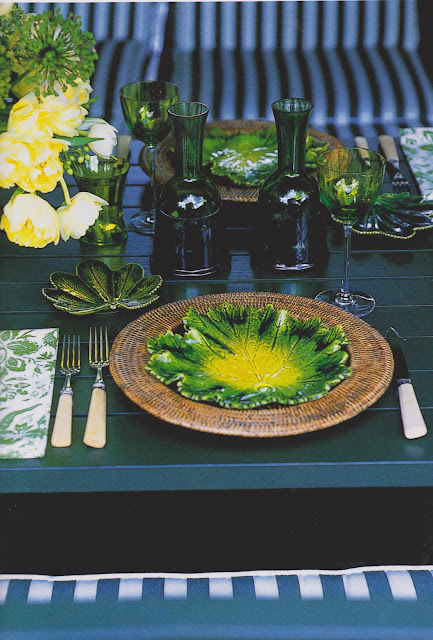So, after a long break, which involved a nice vacation, I have returned...to the topic of tablescapes! Last time, we saw how the master did it--decorator David Hicks, who coined the term. Today, I will show you more contemporary examples.
Attractive tablescapes come in myriad forms, of course. If you collect and display things you truly love, you can hardly go wrong. That said, there are a few simple rules that can help your collectibles coalesce into something visually pleasing.
Rule #1 Go Tall
The first rule of thumb is that, as with any attractive landscape, there must be some variance in height, or else the tablescape will be flat in every sense of the word. One tall object can provide a welcome focal point, serving as a beacon of sorts, that encourages people to walk over and take a look, thus giving your table long distance eye appeal. Often, your tall object will be a lamp, but in lieu of a lamp you can use an obelisk, a candlestick, a print on a stand, a plate, a plant...use your imagination!
 |
Bunny Williams uses a lovely pierced obelisk to enliven her tablescape, above. Below, a cream lamp and shade make a nice graphic statement against the screen, as do all the silvered objects on the marble table.
Courtesy of An Affair with a House . . |

Rule #2 Create a Backdrop
 |
A Michael Smith tablescape from Houses . . |
If your tablescape is against a wall, a propped up piece of art is a great way to help frame and highlight your decorative objects, filling in the empty space like a theater backdrop.
Now, I used to look at these perilously perched pieces of art and cringe: great for photo shoots, maybe, but what about real life--wouldn't those things knock over the minute the table was hit? Well, yes, probably--especially if you don't use museum putty. A good putty can be used against the wall as well as along the base of a picture to really secure it. My favorite kind is
Collectors Hold Museum Putty
. It has a
much stronger bond than the clear versions, yet still lifts off easily. (Note, I wouldn't try this technique with delicate wooden top though, particularly if it's painted, since, as good as this stuff is, it still might lift off some of the surface.)
Rule # 3 The easel is your friend
Pottery and porcelain plates can look terrific in a tablescape, particularly when displayed on an easel or stand. Not only do plates add height and work well as a backdrop, as per the preceding rules, but they also give you the opportunity to display inherited china that might otherwise be hidden away in your attic. Plates are excellent for a burst of color. I love them in unexpected places, such as the bedroom. Small easels can also displaying smaller pictures and calendars. Designers love using easels and examples abound...
I've done it too, in my own, more modest, home...
I bought the Imari plate at auction last fall, below. It wasn't expensive (the estimate was $50-75, I paid $30). I love the colors, though. It looks great with my Persian rug.
Rule #4: Get Started!
Some auctions just lend themselves to collecting. The upcoming auction at Susanin's in Chicago is one such auction. I've included a few tablescape-friendly lots below, but be sure to look at the whole catalog for more, as there are a lot to choose from. I hope all this has inspired you. Happy bidding everyone!
















































